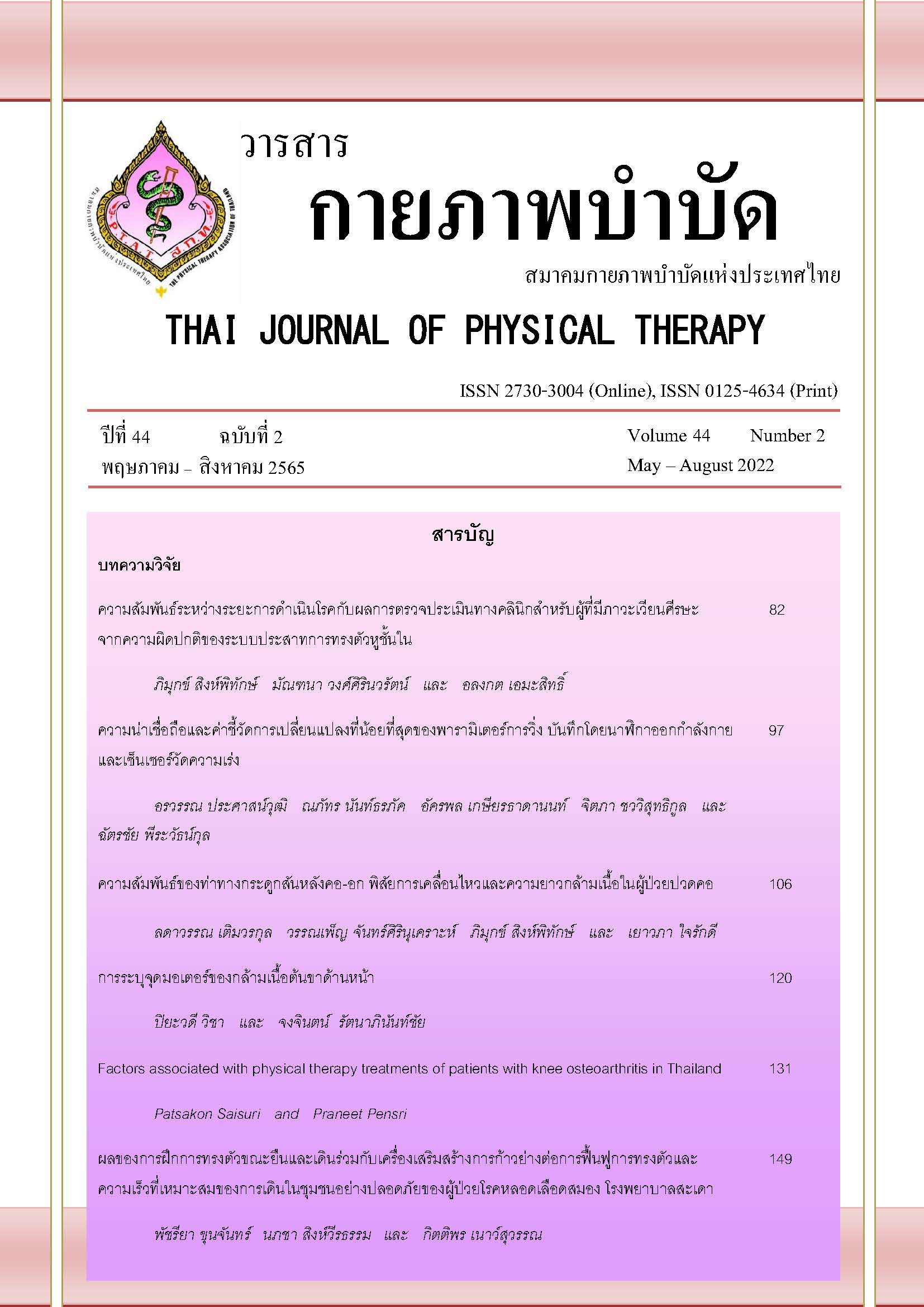ผลของการฝึกการทรงตัวขณะยืนและเดินร่วมกับเครื่องเสริมสร้างการก้าวย่างต่อการฟื้นฟูการทรงตัวและความเร็วที่เหมาะสมของการเดินในชุมชนอย่างปลอดภัยของ ผู้ป่วยโรคหลอดเลือดสมอง โรงพยาบาลสะเดา
Main Article Content
บทคัดย่อ
ที่มาและความสำคัญ: การล้มขณะเดินในผู้ป่วยโรคหลอดเลือดสมองระยะเฉียบพลันมีจำนวนเพิ่มมากขึ้นเรื่อย ๆ เนื่องจากผู้ป่วยไม่สามารถทรงตัวได้อย่างมั่นคง และมีรูปแบบการเดินที่ไม่เหมาะสมกับความเร็วของการเดินในชุมชนอย่างปลอดภัย ดังนั้น การพัฒนาการฝึกการทรงตัวขณะยืนและเดินร่วมกับการใช้เครื่องเสริมสร้างการก้าวย่างจึงเป็นวิธีการสนับสนุนให้ผู้ป่วยมีการทรงตัวที่ดี มีความเร็วที่เหมาะสมขณะเดิน เพื่อลดปัจจัยเสี่ยงในการล้มอีกวิธีหนึ่ง
วัตถุประสงค์: เพื่อศึกษาผลของการฝึกการทรงตัวขณะยืนและเดินร่วมกับเครื่องเสริมสร้างการก้าวย่างต่อการฟื้นฟูการทรงตัวและความเร็วที่เหมาะสมของการเดินในชุมชนอย่างปลอดภัยของผู้ป่วยโรคหลอดเลือดสมอง โรงพยาบาลสะเดา
วิธีการวิจัย: ผู้ป่วยโรคหลอดเลือดสมอง ระยะกึ่งเฉียบพลัน อายุระหว่าง 40-65 ปี จำนวน 27 คน ได้รับการฝึกการทรงตัวขณะยืนและเดินทั่วไป 60 นาที ร่วมกับการใช้เครื่องเสริมสร้างการก้าวย่างโดยมีกิจกรรมที่ฝึกมุ่งเน้นเป้าหมาย (Task oriented) จำนวน 3 กิจกรรม 30 นาที โดยใช้แบบประเมินการทรงตัว (Mini-BESTest) ร่วมกับแบบประเมินความเร็วในการเดินระยะทาง 10 เมตร (10MWT) ระยะเวลาการเก็บรวบรวมข้อมูลในเดือนตุลาคม 2562 ถึง มกราคม 2563 วิเคราะห์ข้อมูลโดยใช้สถิติ Paired t-test และ Wilcoxon Sign Rank Test
ผลการวิจัย: ผลของการฝึกการทรงตัวขณะยืนและเดินร่วมกับเครื่องเสริมสร้างการก้าวย่าง ทำให้ผู้ป่วยมีการทรงตัว และมีความเร็วที่เหมาะสมของการเดินในชุมชนอย่างปลอดภัยเพิ่มมากขึ้น ร่วมกับมีจำนวนการล้มขณะเดินลดลง อย่างมีนัยสำคัญทางสถิติที่ระดับ 0.001
สรุปผล: โรงพยาบาลและสถานบริการสุขภาพในเครือข่าย สามารถนำการฝึกการทรงตัวขณะยืนและเดินร่วมกับเครื่องเสริมสร้างการก้าวย่างไปประยุกต์ใช้ในการฝึกผู้ป่วยโรคหลอดเลือดสมอง เพื่อฟื้นฟูการควบคุมการทรงตัว ร่วมกับควบคุมความเร็วที่เหมาะสมของการเดินในชุมชนอย่างปลอดภัยของผู้ป่วยโรคหลอดเลือดสมองให้เพิ่มมากขึ้น เพื่อลดจำนวนการล้มขณะเดินให้ผู้ป่วยได้อย่างมีประสิทธิภาพ
Article Details

อนุญาตภายใต้เงื่อนไข Creative Commons Attribution-NonCommercial-NoDerivatives 4.0 International License.
เอกสารอ้างอิง
Duncan PW, Zorowitz R, Bates B, Choi JY, Glasberg JJ, Graham GD, et al. Management of Adult Stroke Rehabilitation Care: a clinical practice guideline. Stroke. 2005; 36 (9): e100-43.
Perennou D. Weight bearing asymmetry in standing hemiparetic patients. J Neurol Neurosurg Psychiatry. 2005; 76 (5): 621.
Ratree S, Weerachai S. Neurophysiology. Bangkok: Chulalongkorn University Print;2007. (in Thai)
Horak FB. Postural orientation and equilibrium: what do we need to know about neural control of balance to prevent falls? Age Ageing. 2006; 35 Suppl 2: ii7-ii11.
Siriporn P. Knowledge, attitudes, and behaviors in preventing falls in the elderly. (thesis). Chiang Mai: Chiang Mai University; 1999. (in Thai)
Shumway-Cook A, Woollacott M. Motor Control Translating Research into Clinical Practice. 4th ed: Philadephia, Lippincott William & Wilkins; 2012.
Assantachai P. Falls in the elderly and prevention of common health problems in Elderly and prevention. 2 ed. Bangkok: Department of Preventive and Social Medicine, Faculty of Medicine, Mahidol University; 2011.
Liu TW, Ng GYF, Ng SSM. Effectiveness of a combination of cognitive behavioral therapy and task-oriented balance training in reducing the fear of falling in patients with chronic stroke: study protocol for a randomized controlled trial. Trials. 2018; 19 (1): 168.
World Health Organization. International classification of functioning, disability and health: ICF: World Health Organization, 2001.
Tsang CS, Liao LR, Chung RC, Pang MY. Psychometric properties of the Mini-Balance Evaluation Systems Test (Mini-BESTest) in community-dwelling individuals with chronic stroke. Phys Ther. 2013; 93 (8): 1102-15.
Flansbjer UB, Holmbäck AM, Downham D, Patten C, Lexell J. Reliability of gait performance tests in men and women with hemiparesis after stroke. J Rehabil Med. 2005; 37 (2): 75-82.
Dickstein R. Rehabilitation of gait speed after stroke: a critical review of intervention approaches. Neurorehabil Neural Repair. 2008; 22 (6): 649-60.
Trew M, Everett T. Human Movement An Introductory Text. New York: Churchill Livingstone; 1997.
Faul, F., Erdfelder, E., Lang, A. G., & Buchner, A. G*Power 3: A flexible statistical power analysis program for the social, behavioral, and biomedical sciences. Behav Res Methods, 2007; 39 (2), 175-91.
Cohen, J. Statistical power analysis for the behavioral sciences. 2nd ed. New York: lawrence Erlbaum Associates; 1988.
Gillespie LD, Robertson MC, Gillespie WJ, Sherrington C, Gates S, Clemson LM, et al. Interventions for preventing falls in older people living in the community. Cochrane Database Syst Rev. 2012 (9): Cd007146.
Sherrington C, Whitney JC, Lord SR, Herbert RD, Cumming RG, Close JC. Effective exercise for the prevention of falls: a systematic review and meta-analysis. J Am Geriatr Soc. 2008; 56 (12): 2234-43.
Khongkhaew C. Animation system for analyzing human gait: Songkhla; 2010. (in Thai)
Hair Jr. JF, Black WC, Barbin BJ, Anderson RE. Multivariate data analysis. 7 ed. New Jersey: Pearson Education; 2010.
Thepsrimanon N. Effect of balance training on stability ability of vascular disease patients in the hospital.: Suratthani; 2018.
Thiamwong L, Maneesriwongul W. Risk factors for falls among elderly people living in the community. journal of gerontology and geriatric medicine. 2001; 2 (2): 46-52.
Mahoney FI, Barthel DW. Functional evaluation: The Barthel index. maryland state medical journal. 1965; 14: 61-5.


